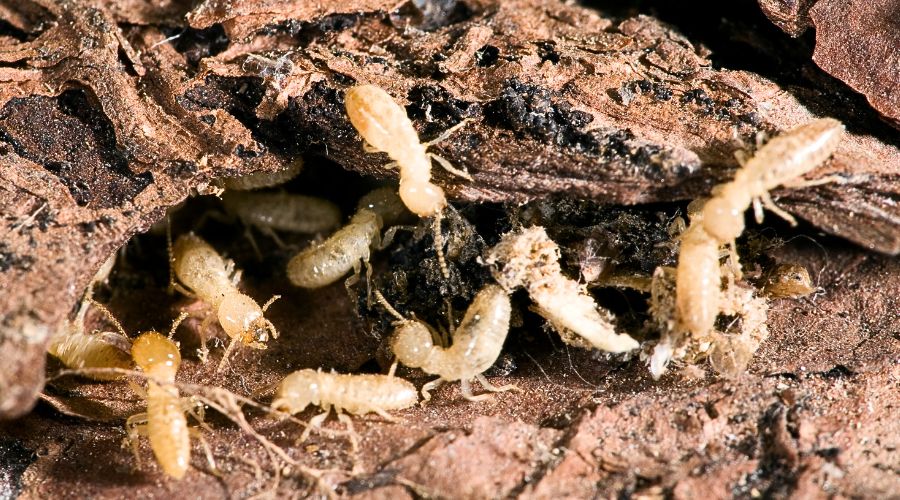Termites are notorious for causing extensive damage to homes and buildings, making addressing an infestation as soon as possible crucial.
There are various methods of termite identification, and explore the different types of termites that may be plaguing your property. Understanding these distinctions is essential in selecting the most appropriate extermination technique.
Dive into this article to discover the common signs of a termite infestation so you can safeguard your home or business from these destructive pests and avoid costly repairs in the long run.
How to Identify Termites
To correctly identify termites, it is important to look for distinguishing characteristics.
Antennae Shape
While ant antennae have a bend or elbow-like shape, termite antennae are straight and appear like a string of beads. This difference in their antennal structure is one of the primary ways to distinguish between these two pests.
Body Shape
The body shape of termites differs significantly from that of ants. Termites have a wide, straight shape with no visible waist constriction. In contrast, ants have thinner waists and narrow bodies with clear segmentation.
Colors
The coloration of these insects also varies: ants may be red, black, or deep brown, whereas most termites range between tan and light brown colors. This distinction in color helps homeowners differentiate between an ant infestation and a potentially more damaging termite problem.
Wing Size
Flying ants and winged termites both possess two sets of wings; however, there’s an important difference in their size proportions. In the case of flying ants, one pair is smaller than the other; conversely, for winged termites, both pairs are equal sized, which makes it easier for you to identify them as potential threats.
Different Types of Termites
Termite infestations can differ greatly, making it important to identify the type of termites present to appropriately address the issue.
Subterranean Termites
Subterranean termites live in the soil and build large nests that can extend deep underground. They are considered one of the most destructive species due to their rapid wood consumption rate, causing extensive damage to homes and other wooden structures.
Dampwood Termites
Dampwood termites, as their name suggests, prefer damp or decaying wood with high moisture content. Unlike subterranean termites, dampwood termites don’t need contact with the ground to survive but prefer wet conditions such as rotting logs or stumps.
Drywood Termites
Drywood termites pose a more significant threat to residential properties than dampwood ones since they don’t need direct contact with soil and can infest dry timber used in construction materials like hardwood floors or furniture pieces directly from air-borne swarms without having access through the soil.
Common Signs of a Termite Infestation
Termites can cause significant damage to your home, and it’s essential to identify the signs of an infestation early on. Here are some common indicators that termites may be present on your property:
Hollow Wood
Tapping on wooden structures or furniture and hearing a hollow sound could indicate termite activity. Termites consume wood from the inside out, leaving behind a thin veneer that produces a hollow noise when tapped.
Mud Tubes
Subterranean termites create mud tubes traveling between their nests and food sources. These pencil-sized tubes are made from soil and feces and can often be found along foundations, walls, or other structures where termites can access wood.
Head Banging
Soldier termites produce clicking sounds by banging their heads against surfaces when disturbed. Listen closely near areas with suspected termite activity. You might hear these noises as an indication of their presence.
Swarm Evidence
In springtime or after heavy rains, reproductive winged termites called swarmers leave their colonies to mate and establish new nests. Finding discarded wings around windowsills or doors is evidence of swarming activity nearby.
Peeling or Bubbling Paint
The moisture termite tunnels produce can cause the paint on walls to peel or bubble up. This sign could also indicate water damage but should not be ignored if accompanied by other signs of termite infestation.
Flying Ants vs. Winged Termites
It’s important to note that winged termites can be mistaken for flying ants. Nevertheless, there are some key contrasts between the two bugs, for instance, their antenna shape and physical makeup.
Frass
Drywood termites produce wood-colored droppings called frass as they consume wood. So if you find small piles of frass near wooden structures or furniture, it could indicate termite activity.
Sighting Live Termites
Finding live termites in your home is a clear sign of an infestation. They may be found around windowsills, doors, or other areas where they have access to food sources.
How to Kill Termites
Several methods can help you eliminate these destructive pests effectively and naturally. This section will explore different approaches to eliminating termites.
Flooding
Termites can drown, but only after being submerged in water for an extended period. Depending on the type of termite, they can survive underwater for up to 16 to 30 hours before they start dying.
Low Temperature
If done correctly, chilling the air around termites is another effective method of killing them. To exterminate termites using cold temperatures, chill the infested wood to -20 degrees Fahrenheit for at least 30 minutes.
Salt Treatment
Salt is a natural and efficient way of eliminating termites from your home. To use this method:
- Mix equal parts salt and warm water in a jar until dissolved completely.
- Fill a syringe with the salty solution.
- Inject the mixture into all affected areas where you suspect termite activity or damage.
Sunlight Exposure
Termites cannot survive in sunlight, so exposing infested objects or areas to bright light can help kill them. Allow natural sunlight into your home throughout the day and, if possible, move affected items outdoors for maximum exposure.
Conclusion
Termites can be destructive, but with the correct information and means, they can be eliminated. It’s important to first identify your type of termite infestation before taking action. If you suspect a termite infestation in your home or property, it’s important to act quickly by contacting the termite control experts at Romney Pest Control. We have years of experience in eliminating termites from home and commercial properties. Give us a call to schedule your termite inspection today.




